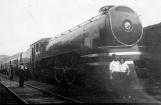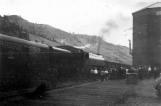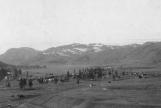15
Waiting for the train on the Midway Station platformCirca 1918
Midway, BC
 Credits:
Credits:Glen Smith collection
Kettle River Museum
16
"they shipped a whole carload of it. And then many ranchers would get their grain from it.."1915-
The Boundary
 Credits:
Credits:Rose Boltz, Midway BC, 2008
19
"In the summer we'd go down to the rock cuts where the work train was puffing, sighing and emitting the odd groan, waiting for the steam shovel to fill its cars at either end of its run - which was all of two flat-car lengths. It shunted back and forth giving out a sharp toot now and then to signal the train to move back or ahead. The shovel seemed like an oversized toy compared to its daddy engine, which would give a short blat and be off with a snort to dump the load from the gravel cars."- Stanley Bubar, Midway BC, 1986
20
CPR's new streamlined locomotive for its Calgary/Edmonton run tours the BoundarySummer 1936
Midway, BC
 Credits:
Credits:Kettle River Museum
21
"This train was built for the high speed CPR run between Calgary and Edmonton. The photograph was taken in Midway on its special excursion run across Canada during the summer of 1936. The CPR toured the train across Canada to introduce the equipment to the traveling public - its first streamlined locomotive and passenger train cars. On the train's return trip to the east, it came through on the Kettle Valley and Kootenay Divisions, eastbound. "- Joe Smuin, Coquitlam BC, 2008
22
CPR's new streamlined train attracted crowds when it stopped in MidwaySummer 1936
Midway, BC
 Credits:
Credits:Kettle River Museum
23
The means to move goods to and from the Boundary as never before made new industry possible and existing industry more efficient. Ore from the Beaverdell mines could be shipped direct to the smelter inTrail, instead of being hauled by freight wagon to the Columbia & Western railhead at Midway.The timber industry flourished and communities along the line prospered.
24
Looking west through Midway and the Kettle Valley LineCirca 1920
Midway, BC
 Credits:
Credits:Kettle River Museum
25
Lumber from Boundary Sawmills could be shipped by railCirca 1930
Midway, BC
 Credits:
Credits:Kettle River Museum
26
Midway's first sawmill was built in 1910, to mill timber fallen by the local ranchers and homesteaders. The site was ideal - beside the Kettle River near a shallows where logs from the annual log drive could easily be detained. However, the mill burned down and the land stood unused for 12 years. The log drive passed by, bound for mills in Grand Forks and Billings near Cascade.With the arrival of the Kettle Valley Railway the Boundary was growing again, as was the market for lumber, and so in 1926 the land changed hands. Boundary Sawmills was built on the site of the former mill, even more ideal now that lumber could be shipped directly through Penticton to Vancouver.
1926 pre-dated the advent of electricity in the Kettle Valley by more than twenty years; the river was damned to hold logs and to supply water for turbines, and sawdust from the head saw was burned to fuel a steam engine that powered the mill.
27
Hauling logs to the banks of the Kettle River for the annual log driveCirca 1920
The Boundary
 Credits:
Credits:Kettle River Museum


